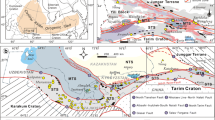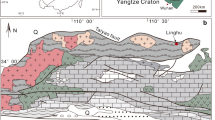Abstract
The North China Craton (NCC) has been continuously reactivated since the Mesozoic and this decratonization is responsible for its economically important gold mineralization in the Mesozoic. The Early Cretaceous (110–130 Ma) gold mineralization in the NCC has been well-studied due to its significance, but little attention has been given to other episodes of gold mineralization related to polyphased reactivation of the NCC. The Xinfang mesozonal gold deposit (143 Ma) in the Liaodong Peninsula is related to the one of the episodes of the Yanshanian orogeny. The orebodies of the Xinfang gold deposit were controlled by the low angle transpressive fault systems and hosted by the Neoarchean monzogranitic gneiss. Fluid inclusion microthermometry reveals that the mineralizing temperatures range from 220 to 280 °C, with salinities from 6 wt.% NaCl eqv. to 15 wt.% NaCl eqv., pressures from 199 to 321 Ma. The S isotopic characteristics of sulfides not only record a heterogeneous source including magmatic or gneissic sulfur but also record inter-mineral isotope fractionation. The initial 87Sr/86Sr values of pyrite (0.713 480–0.729 031) indicate a radiogenic crustal origin for the sources. The metamorphic dehydration of the underlying basement resulted in the genesis of the Xinfang gold deposit. We summarize three episodes of gold mineralization in the Liaodong Peninsula related to continuous reactivation of the NCC, which indicates a great exploration potential of this area.
Similar content being viewed by others
References Cited
Bierlein, F. P., Crowe, D. E., 2000. Phanerozoic Orogenic Lode Gold Deposits. In: Hagemann, S. G., Brown, P. E., eds., Gold in 2000. Society of Economic Geologists, 13: 103–139. https://doi.org/10.5382/rev.13.03
BGMELP (Bureau of Geology and Mineral Exploration of the Liaoning Province), 1989. Regional Geology of Liaoning Province. Geological Publishing House, Beijing. 1–856 (in Chinese with English Abstract)
Bodnar, R. J., 1993. Revised Equation and Table for Determining the Freezing Point Depression of H2O-NaCl Solutions. Geochimica et Cosmochimica Acta, 57: 683–684. https://doi.org/10.1016/0016-7037(93)90378-a
Collins, P. L. F., 1979. Gas hydrates in CO2-Bearing Fluid Inclusions and the Use of Freezing Data for Estimation of Salinity. Economic Geology, 74: 1435–1444. https://doi.org/10.2113/gsecongeo.74.6.1435
Colvine, A. C., Fyon, J. A., Heather, K. B., et al., 1988. Archean Lode Gold Deposits in Ontario. Ontario Ministry of Northern Development and Mines, Ontario. 1–136
Faure, G., Powell, J. L., 1972. Strontium Isotope Geology. Springer-Verlag Berlin, Heidelberg. 1–189
Goldfarb, R., Baker, T., Dube, B., et al., 2005. Distribution, Character and Genesis of Gold Deposits in Metamorphic Terranes. In: Hedenquist, J. W., Thompson, J. F. H., Goldfarb, R. G., et al., eds., Economic Geology 100th Anniversary Volume, Society of Economic Geologists, Littleton, Colorado, USA. 407–450. https://doi.org/10.5382/av100.14
Gu, C. C., Zhu, G., Zhai, M. J., et al., 2016. Features and Origin Time of Mesozoic Strike-Slip Structures in the Yilan-Yitong Fault Zone. Science China Earth Sciences, 59(12): 2389–2410. https://doi.org/10.1007/s11430-016-5334-4
Guo, D. Z., Wei, J. H., Zhang, K. Q., et al., 2005. The Isotope Geochemical Characterisitcs and Ore-Forming Time of Zhuanghe Gold Deposit, Eastern Liaoning. Acta Geologica Sinica, 79(5): 671–678 (in Chinese with English Abstract)
Hoefs, J., 2018. Stable Isotope Geochemistry (8th Ed.). Springer, Switzerland. 1–437
Jin, J., Gao, B. S., Zhang, H. D., 1998. Study on Feasibility of Deep Development in Xin-Fang Gold Mine of Liaoning Province. Gold, 19(5): 23–28 (in Chinese with English Abstract)
Kusky, T. M., Windley, B. F., Zhai, M. G., 2007. Tectonic Evolution of the North China Block: From Orogen to Craton to Orogen. Geological Society, London, Special Publications, 280(1): 1–34. https://doi.org/10.1144/sp280.1
Li, J. W., Bi, S. J., Selby, D., et al., 2012. Giant Mesozoic Gold Provinces Related to the Destruction of the North China Craton. Earth and Planetary Science Letters, 349/350: 26–37. https://doi.org/10.1016/j.epsl.2012.06.058
Li, Q., Chen, F., Wang, X., et al., 2005. Ultra-Low Procedural Blank and the Single-Grain Mica Rb-Sr Isochron Dating. Chinese Science Bulletin, 50(24): 2861–2865. https://doi.org/10.1360/982005-984
Liu, C., Zhu, G., Zhang, S., et al., 2018. Mesozoic Strike-Slip Movement of the Dunhua-Mishan Fault Zone in NE China: A Response to Oceanic Plate Subduction. Tectonophysics, 723: 201–222. https://doi.org/10.1016/j.tecto.2017.12.024
Liu, J., Zhang, L. J., Wang, S. L., et al., 2019. Formation of the Wulong Gold Deposit, Liaodong Gold Province, NE China: Constraints from Zircon U-Pb Age, Sericite Ar-Ar Age, and H-O-S-He Isotopes. Ore Geology Reviews, 109: 130–143. https://doi.org/10.1016/j.oregeorev.2019.04.013
Mao, J. W., Goldfarb, R., Zhang, Z. W., et al., 2002a. Gold Deposits in the Xiaoqinling-Xiong’ershan Region, Qinling Mountains, Central China. Mineralium Deposita, 37(3/4): 306–325. https://doi.org/10.1007/s00126-001-0248-1
Mao, J. W., Qiu, Y. M., Goldfarb, R., et al., 2002b. Geology, Distribution, and Classification of Gold Deposits in the Western Qinling Belt, Central China. Mineralium Deposita, 37(3/4): 352–377. https://doi.org/10.1007/s00126-001-0249-0
McCuaig, T. C., Kerrich, R., 1998. P-T-t-Deformation-Fluid Characteristics of Lode Gold Deposits: Evidence from Alteration Systematics. Ore Geology Reviews, 12(6): 381–453. https://doi.org/10.1016/s0169-1368(98)80002-4
Miao, L. C., Qiu, Y. M., Fan, W. M., et al., 2005. Geology, Geochronology, and Tectonic Setting of the Jiapigou Gold Deposits, Southern Jilin Province, China. Ore Geology Reviews, 26(1/2): 137–165. https://doi.org/10.1016/j.oregeorev.2004.10.004
Mikucki, E. J., 1998. Hydrothermal Transport and Depositional Processes in Archean Lode-Gold Systems: A Review. Ore Geology Reviews, 13(1–5): 307–321. https://doi.org/10.1016/s0169-1368(97)00025-5
Qin, J. H., Liu, C., Chen, Y. C., et al., 2019. Timing of Lithospheric Extension in Northeastern China: Evidence from the Late Mesozoic Nianzishan A-Type Granitoid Complex. Journal of Earth Science, 30(4): 689–706. https://doi.org/10.1007/s12583-018-0996-9
Phillips, G. N., Powell, R., 2010. Formation of Gold Deposits: A Metamorphic Devolatilization Model. Journal of Metamorphic Geology, 28(6): 689–718. https://doi.org/10.1111/j.1525-1314.2010.00887.x
Seal, R. R. I., 2006. Sulfur Isotope Geochemistry of Sulfide Minerals. Reviews in Mineralogy and Geochemistry, 61(1): 633–677. https://doi.org/10.2138/rmg.2006.61.12
Sibson, R. H., Robert, F., Poulsen, K. H., 1988. High-Angle Reverse Faults, Fluid-Pressure Cycling, and Mesothermal Gold-Quartz Deposits. Geology, 16(6): 551–555. https://doi.org/10.1130/0091-7613(1988)016<0551:harffp>2.3.co;2
Taylor, H. P., 1974. The Application of Oxygen and Hydrogen Isotope Studies to Problems of Hydrothermal Alteration and Ore Deposition. Economic Geology, 69(6): 843–883. https://doi.org/10.2113/gsecongeo.69.6.843
Wu, F., Lin, J., Wilde, S., et al., 2005a. Nature and Significance of the Early Cretaceous Giant Igneous Event in Eastern China. Earth and Planetary Science Letters, 233(1/2): 103–119. https://doi.org/10.1016/j.epsl.2005.02.019
Wu, F. Y., Yang, J. H., Wilde, S. A., et al., 2005b. Geochronology, Petrogenesis and Tectonic Implications of Jurassic Granites in the Liaodong Peninsula, NE China. Chemical Geology, 221(1/2): 127–156. https://doi.org/10.1016/j.chemgeo.2005.04.010
Wu, Y. F., Evans, K., Li, J. W., et al., 2019. Metal Remobilization and Ore-Fluid Perturbation during Episodic Replacement of Auriferous Pyrite from an Epizonal Orogenic Gold Deposit. Geochimica et Cosmochimica Acta, 245: 98–117. https://doi.org/10.1016/j.gca.2018.10.031
Yan, D. P., Zhou, M. F., Song, H. L., et al., 2006. Mesozoic Extensional Structures of the Fangshan Tectonic Dome and Their Subsequent Reworking during Collisional Accretion of the North China Block. Journal of the Geological Society, 163(1): 127–142. https://doi.org/10.1144/0016-764904-154
Yang, J. H., Zhou, X. H., 2001. Rb-Sr, Sm-Nd, and Pb Isotope Systematics of Pyrite: Implications for the Age and Genesis of Lode Gold Deposits. Geology, 29(8): 711–714. https://doi.org/10.1130/0091-7613(2001)029<0711:rssnap>2.0.co;2
Yang, J. H., Wu, F. Y., Wilde, S. A., 2003. A Review of the Geodynamic Setting of Large-Scale Late Mesozoic Gold Mineralization in the North China Craton: An Association with Lithospheric Thinning. Ore Geology Reviews, 23(3/4): 125–152. https://doi.org/10.1016/s0169-1368(03)00033-7
Yang, J. H., Wu, F. Y., Wilde, S. A., et al., 2007. Petrogenesis of Late Triassic Granitoids and Their Enclaves with Implications for Post-Collisional Lithospheric Thinning of the Liaodong Peninsula, North China Craton. Chemical Geology, 242(1/2): 155–175. https://doi.org/10.1016/j.chemgeo.2007.03.007
Yu, G., 2005. Re-Os Dating of Gold-Bearing Arsenopyrite of the Maoling Gold Deposit, Liaoning Province, Northeast China and Its Geological Significance. Chinese Science Bulletin, 50(14): 1509–1252. https://doi.org/10.1360/04wd0229
Zeng, Q. D., Chen, R. Y., Yang, J. H., et al., 2019. The Metallogenic Characteristics and Exploring Ore Potential of the Gold Deposits in Eastern Liaoning Province. Acta Petrologica Sinica, 35(7): 1939–1963. https://doi.org/10.18654/1000-0569/2019.07.01 (in Chinese with English Abstract)
Zhang, P., Li, B., Li, J., et al., 2016. Re-Os Dating and Its Geological Implication of Gold Bearing Pyrite from the Baiyun Gold Deposit in Liaodong Rift. Geotectonica et Metallogenia, 40(4): 731–738 (in Chinese with English Abstract)
Zhang, S. H., Zhao, Y., Davis, G. A., et al., 2014. Temporal and Spatial Variations of Mesozoic Magmatism and Deformation in the North China Craton: Implications for Lithospheric Thinning and Decratonization. Earth-Science Reviews, 131: 49–87. https://doi.org/10.1016/j.earscirev.2013.12.004
Zhang, S., Zhu, G., Liu, C., et al., 2018. Strike-Slip Motion within the Yalu River Fault Zone, NE Asia: The Development of a Shear Continental Margin. Tectonics, 37(6): 1771–1796. https://doi.org/10.1029/2018tc004968
Zhao, G. C., 2014. Precambrian Evolution of the North China Craton. Elsvier, Amsterdam. 1–194
Zhao, G. C., Zhai, M. G., 2013. Lithotectonic Elements of Precambrian Basement in the North China Craton: Review and Tectonic Implications. Gondwana Research, 23(4): 1207–1240. https://doi.org/10.1016/j.gr.2012.08.016
Zhou, T. H., Goldfarb, R., 2002. Tectonics and Metallogeny of Gold Deposits in China. Mineralium Deposita, 37(3/4): 247–248. https://doi.org/10.1007/s00126-001-0240-9
Zhou, X. M., Sun, T., Shen, W. Z., et al., 2006. Petrogenesis of Mesozoic Granitoids and Volcanic Rocks in South China: A Response to Tectonic Evolution. Episodes, 29(1): 26–33. https://doi.org/10.18814/epiiugs/2006/v29i1/004
Zhu, G., Liu, G. S., Niu, M. L., et al., 2009. Syn-Collisional Transform Faulting of the Tan-Lu Fault Zone, East China. International Journal of Earth Sciences, 98(1): 135–155. https://doi.org/10.1007/s00531-007-0225-8
Zhu, G., Jiang, D. Z., Zhang, B. L., et al., 2012. Destruction of the Eastern North China Craton in a Backarc Setting: Evidence from Crustal Deformation Kinematics. Gondwana Research, 22(1): 86–103. https://doi.org/10.1016/j.gr.2011.08.005
Zhu, G., Liu, C., Gu, C. C., et al., 2018. Oceanic Plate Subduction History in the Western Pacific Ocean: Constraint from Late Mesozoic Evolution of the Tan-Lu Fault Zone. Science China Earth Sciences, 61(4): 386–405. https://doi.org/10.1007/s11430-017-9136-4
Zhu, R. X., Yang, J. H., Wu, F. Y., 2012. Timing of Destruction of the North China Craton. Lithos, 149: 51–60. https://doi.org/10.1016/j.lithos.2012.05.013
Zhu, R. X., Fan, H. R., Li, J. W., et al., 2015. Decratonic Gold Deposits. Science China Earth Sciences, 58(9): 1523–1537. https://doi.org/10.1007/s11430-015-5139-x
Zhu, Z. Y., Jiang, S. Y., Mathur, R., et al., 2018. Iron Isotope Behavior during Fluid/Rock Interaction in K-Feldspar Alteration Zone—A Model for Pyrite in Gold Deposits from the Jiaodong Peninsula, East China. Geochimica et Cosmochimica Acta, 222: 94–116. https://doi.org/10.1016/j.gca.2017.10.001
Acknowledgments
This research was financially supported by the National Key Research and Development Program of China (No. 2018YFC0603801). We thank Dr. Kuidong Zhao, Zeyang Zhang, Pan Qu, Mu Liu for their help in LA-MC-ICP-MS sulfur isotope, fluid inclusion microthermometry, Raman analysis, and Rb-Sr isotopic analysis, respectively. Field trips were assisted by Chuang Yu, Fu-xing Liu and Wei Wang. We thank the three anonymous reviewers for their comments that greatly assisted in improving the manuscript. Editor Shuhua Wang is thanked for the editing. The final publication is available at Springer via https://doi.org/10.1007/s12583-020-1074-7.
Author information
Authors and Affiliations
Corresponding author
Rights and permissions
About this article
Cite this article
Liu, S., Chen, B., Zheng, J. et al. Genesis of the Xinfang Gold Deposit, Liaodong Peninsula: Insights from Fluid Inclusions and S-Sr Isotopic Constraints. J. Earth Sci. 32, 68–80 (2021). https://doi.org/10.1007/s12583-020-1074-7
Received:
Accepted:
Published:
Issue Date:
DOI: https://doi.org/10.1007/s12583-020-1074-7




